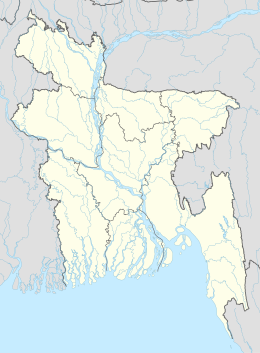|
Bhasan Char
Bhasan Char (Bengali: ভাসানচর), also known as Char Bhasani (Bengali: চর ভাসানী), is an island in Hatiya Upazila, Bangladesh.[1] Until 2019[2] it was known as Thengar Char.[1][3] It is located in the Bay of Bengal, about 6 kilometres (3.7 mi) from Sandwip island and 37 miles (60 km) from the mainland.[4] GeographyBhasan Char lies to the immediate southwest of Sandwip. It is a low-lying island formed from silt deposits, and is only accessible by boat and helicopter. As the island’s coastline is constantly shifting due to its newness and its position in the Ganges Delta, the refugee camp is protected by a system of levees. It is vulnerable to the area’s frequent tropical cyclones.[5] HistoryThe island was formed by Himalayan silt in 2006.[1] It spans 40 square kilometres (15 sq mi; 4,000 ha).[6] The Government of Bangladesh planned to construct a total of 1,440 buildings, including 120 cyclone shelters, to relocate 100,000 Rohingya refugees from the mainland camps of Cox's Bazar.[7] The Government of Bangladesh first suggested resettling Rohingya refugees on the island in June 2015.[8] The proposal was characterized by the United Nations Refugee Agency as "logistically challenging".[8] On January 26, 2017, the Bangladeshi government ordered their resettlement nonetheless.[1][3][4] Human Rights Watch called it "a human rights and humanitarian disaster in the making".[1] In August 2019 the government announced an expansion of the Ashrayan Project (Ashrayan-3) to build 100,000 homes.[9] The houses are built four feet above the ground, in order to protect the refugees from high tidal waves.[10] The public works had amounted to 309.5 million takas by December 2019, a 34% increase from the initial allocation.[2] The additional projects include raising the flood-protection embankment from 9 feet (2.7 m) to 19 feet (5.8 m), and construction of cluster villages, mosques, shelter stations, hospitals, water channelling infrastructure, roads, infrastructure for farming and numerous other land development works under the project.[2][11] The Bangladesh Navy built much of the infrastructure.[11] In January 2020, the project was moving forward despite opposition from Rohingya leaders and human rights groups. Bangladesh's minister for refugee affairs stated the island is "ready for habitation", though he gave no timetable for the relocation. The government had not permitted foreign journalists or Rohingya leaders to travel to Bhasan Char at the time.[12] Between December 2020 and January 2021 the first two groups totalling around 4,000 Rohingya had already been sent to the island. On 29 January another 1,778 Rohingya refugees started their journey to the island, with a fourth group to be moved the next day. The process of moving Rohingya refugees will continue until 100,000 have arrived in the island, according to authorities. The Bangladesh government had spent $112 million by this time.[11] A United Nations delegation visited the island for the first time from 17 to 20 March 2021. By this time 13,000 Rohingya lived on the island. The UN Refugee Agency has signed a memorandum in helping the refugees here.[13] The Rohingya may work and contribute to the economy,[11] but may not move off the island.[13] In principle, the island was seen as a temporary solution until the refugees could return home.[11] Some of the first group to move to the island spoke of being coerced. Others spoke of deciding to relocate from the overcrowded camps of Cox's Bazar due to the frequent violence there. The Bangladesh government hoped to assuage UN concerns and that the refugees would get international assistance.[13] As of May 2022, the Government of Bangladesh has relocated approximately 28,000 Rohingya refugees to Bhasan Char.[14] The Prime Minister of Bangladesh, Sheikh Hasina, declared that 35,000 Rohingya were transferred to Bhasan Char to "keep Rohingya youth away from criminal activities." She also emphasized the difficulty of repatriating Rohingya back to Myanmar due to the civil war, and preventing foreign armed groups from using Bangladesh as a guerrilla sanctuary.[15] As of 30 September 2024, 35,629 people, including 8,477 families, live in the island.[16] References
|
||||||||||||||||||||||||||||||
